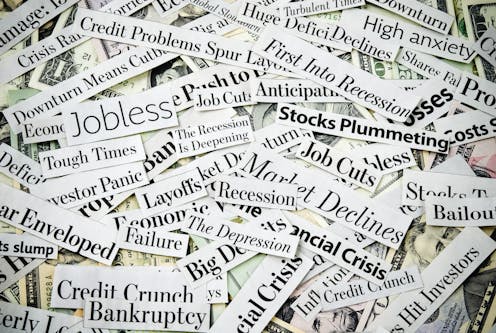Job figures are coming out, and here’s my prediction: The markets will overreact to the headlines
For a more nuanced view, dig beneath the numbers that make the news.

As the saying goes, “There are lies, damn lies and statistics.”
And on the first Friday of every month, the American public gets a ton of new statistics to peruse. That’s when the U.S. Bureau of Labor Statistics releases its latest jobs figures. Within minutes of the data drop, news organizations send out push alerts, pundits start opining, and the headlines — and headline numbers — coagulate into a simple narrative, often along the lines of “Jobs are up; the economy is saved” or “Jobs are down; we’re all doomed.”
These narratives consistently influence investors and financial markets.
As a professor of finance, I think these simple storylines aren’t helpful to investors. In fact, they’re actually harmful. Initial narratives stick even when underlying statistics contradict the numbers that make the headlines. So on June 7, 2024, when the latest jobs data will be released, I predict that financial markets will overreact to the headlines.
I get it: There’s so much information in the two job reports the Bureau of Labor Statistics releases each month that you can pick and choose the data you find important. But ignoring nuance isn’t a good investment strategy. And it turns out that economic reality is too complex to fit neatly into a headline. For proof, consider how markets responded to the past two months of jobs data.
Dig into the data
Let’s start with the April jobs numbers, which came out on May 3.
The headline numbers were worse than expected: The unemployment rate ticked up to 3.9% from 3.8% the previous month, and both nonfarm payrolls and private nonfarm payrolls were lower than anticipated.
The stock market rallied on this seemingly bad news because it saw the disappointing jobs reports as a sign that inflation might be slowing. That, in turn, could encourage the Federal Reserve to put interest rate cuts back on the table for 2024 – or at least investors had hoped.
But things look a little more complex when you dig into the data.
The unemployment rate did get worse, rising one-tenth of a percentage point with virtually no change in the labor force participation rate. On its surface, that doesn’t look so good: It seems the unemployment rate has increased by 10 basis points. But that’s because the bureau calculates the unemployment rate only out to one decimal place. But what if you go out to two decimal places?
To do that, you need to crunch some numbers yourself.
You can do that by going to the the bureau’s Current Employment Statistics news release, navigating various rows and columns, and then getting the calculator out to work out a figure for the month that goes one decimal place further than what’s released to the media. Then you have to repeat the process for last month’s data.
When you do that, you can see that the unemployment rate barely budged in April: It rose from 3.83% in March to 3.86%, an increase of just .03%, or 3 basis points. This suggests those seemingly disappointing official unemployment numbers weren’t actually that disappointing after all.
Good headlines, bad news
You’ll see something similar if you look at the March jobs figures, which came out on April 5.
The headline numbers came in much better than expected, and financial markets celebrated. Total nonfarm payrolls came in way above expectations, at 303,000 jobs created, as did private nonfarm payrolls. The official unemployment rate dipped to 3.8%. On its surface, all great news.
But you would get a different perspective if you dig deeper into the data — especially the figures showing how many jobs were created in government and in manufacturing. You have to scroll a few pages into the Current Employment Statistics news release to find the relevant data – in “Employment Situation Summary Table B” – but it’s all there.
If you look at the March statistics, you’ll see that positions in government make up more than 20% of new jobs added. What’s more, the data shows that zero manufacturing jobs were created in March.
This data suggests the March headline numbers — which suggested a very robust job market — may have been deceptively sunny. Too many jobs were created in government, and too few in manufacturing. That’s not a very healthy jobs market.
When pundits and the public ponder the job statistics that come out on the first Friday of each month, they should be be careful not to simply accept the headlines as the entire story.
When it comes to the economy, simple narratives can be misleading.
Jeffrey Hart does not work for, consult, own shares in or receive funding from any company or organization that would benefit from this article, and has disclosed no relevant affiliations beyond their academic appointment.
Read These Next
The ‘one chatbot per child’ model for AI in classrooms conflicts with what research shows: Learning
AI tutors are often held up as an ideal, but prioritizing individualized teaching can detract from the…
Christmas trees are more expensive than ever in Colorado — what gives?
Most Christmas trees are imported from other states, which drives up costs.
Pandas, pingpong and ancient canals: President Xi’s hosting style says a lot about Chinese diplomacy
During a recent visit to China, French President Emmanuel Macron was given the diplomatic works.






